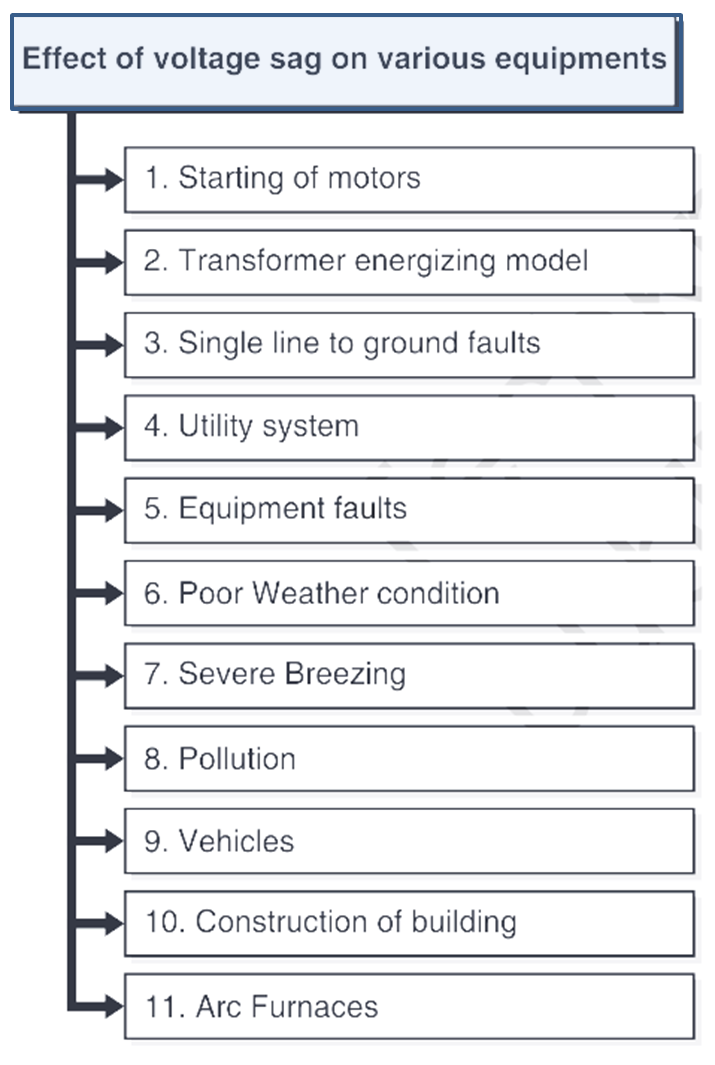Voltage sag and interruption are commonly related to power quality problems. Voltage sag refers to voltage dips typically for 0.5 to 30 cycles.
During sag, RMS voltage dips with 10

Fig. 1: Waveform explaining voltage sag.
Sources of Voltage Sag
1. Voltage sag and its interruption generally occur due to short ciicuit faults on the system. An unexpected increase in load yields an unexpected fall in current or voltage. This sudden increase in the load may cause voltage sag in
- Motors
- Switching operation
- Abrupt faults
2. As starting of the motor requires more current during start than at running, thus starting of motor is one of the reasons for the voltage sag (Fig. 2).

Fig. 2: Voltage sag due to motor starting
3. When line-to-ground fault occurs, there will be voltage sag until a protective switchgear operates.
4. Some unwanted accidents in power lines like flickering; lightning may cause line to ground faults, which in turn cause voltage sag.
5. When loads changes often, if causes voltage sags.
6. The transformer’s connection is another reason for voltage sag.
Causes of Voltage Sag (or) Effect of Voltage Sag on Various Equipment
The voltage sag primarily occurs due to:

Fig. 3: Effect of voltage sag on various equipment.
Starting of motors
Initially, a motor requires a large current during its start. The current ranges between 80 to 100
Traiisformer energizing model
Abrupt energizing of load tends to reduce the voltage. If the source is competent to run with this high load, then the voltage can return back to its initial voltage.
Single line to ground faults
The fault currents cause voltage sag in the power line.
Utility system
For any unwanted reason if the circuit breaker is tripped off, then the feeder from the distributing side is temporally cut off. The remaining feeder lines, will treat this as voltage sag and spread this to the consumer on the other lines. The degree of voltage lag may vary according to the supplied line voltage.
Equipment faults
If the system fails due to voltage imbalance like overvoltage/Undervoltage, the equipment installed in the substation will be observed on other feeder lines across the system.
Poor Weather condition
Lightening and thunder cause noteworthy voltage sag. The lightening caused due to voltage sag attack the power line and then to the ground, which form a line to ground (L-G) fault.
Severe Breezing
Heavy breeze can cut off the tree, which then fall on the power lines. As the branch of the tree touches the power line, it creates line to ground faults.
Pollution
In coastal areas, over a period of time, the accumulation of salt on the power line causes voltage sag.
Vehicles
Due to heavy traffic, vehicle collides with the utility pole, which tends the wire to touch. So the protective switchgear functions, which create voltage sag.
Construction of building
For constructing new buildings, the underground is dugged. While digging the underground cable gets damaged, which causes voltage sag.
Arc Furnaces
They operate with capacitor banks and harmonic filter. The capacitor hank causes the voltage to rise. To mitigate the voltage sag, the capacitor bank should be turned on else they are switched off.

Service system
Voltage sag can occur in both transmission and distribution voltages. The voltage sag with higher voltage tends to enter the utility system and gets spread to the other transmitters through transformers.

Inside Plants
Voltage sags are sometimes created inside the industrial plants even though utility is not involved. These are mainly due to the initial start of motors.